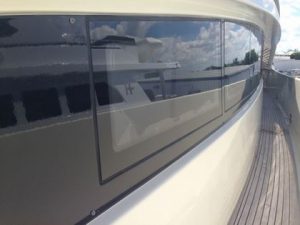ProCurve Glass Design, Inc. strives to produce the best custom curved glass products possible. Templates play a critical role in this process. In order to produce a perfect part for our customer, we need a clear definition of what shape we need to produce and this is where a template comes into play.

What is a Template?
If you aren’t familiar with what a template is, it’s a reliable fixture that communicates critical dimensional information required to produce a part. A template can represent the exact size and shape of the glass or it can represent the surface or fixture the glass will be installed in. We make your part to match the template and do quality checks against information from the template to ensure the part you get matches. An accurate template is critical for good final results and a good template needs to be rigid and clearly identifiable. Rigidity is an often-overlooked detail that can have a meaningful effect on the results of the product as significant flexing of a shape can occur on non-rigid parts when supported differently. One common issue is with remaking out-of-production car windshields which are thin glass. When the glass is installed in the car, the frame will force the glass into the shape required, but once removed, the glass can flex multiple inches. For this reason, simply sending us a removed window is insufficient to act as a good template without adding external bracing to the window to make it rigid before removing it from the frame.
Template Terms to Know
Concave and Convex are terms frequently used. Concave refers to a shape facing in towards the center and convex refers to a shape facing away from the center. An example would be a balloon, the surface of the balloon INSIDE the balloon is concave while the surface on the outside of the balloon is convex.
A check fixture is a type of template that is made so that the final part will fit into the check fixture. When the part is finished, we can place the part into the fixture and clearly see the match with the fixture. There are also other template terms that will help you get a better understanding of the templates that can be produced.
What Else Should You Know?
There is no set rule on how or what materials you must use to make a template or who must make them. The accuracy of the information is the only thing that is critical and so making the template out of whatever is most comfortable for you is most critical. Wood, fiberglass, steel, aluminum, carbon-fiber, plastic, Papier-mâché, or anything else are confident can be make to clearly and accurately communicate the exact shape we need to produce.
The digital revolution
For the last decade or more, digital templates have become more and more common. A “digitizer” can scan the physical world and translate that into a computer model. The process is a little more complicated than that statement might sound and still requires training and skill to produce them accurately, but every year these digitizers and their software get more advanced and more often used. In fact, every physical template we receive ends up getting digitized in our facility as part of our production process.
As you can see, there is a lot that goes into creating a template successfully. If you need more details on how to do it properly, call ProCurve Glass Design, Inc. at 215-441-9101 today to get additional help. We are experienced when it comes to making templates and using them to create custom curved glass.
